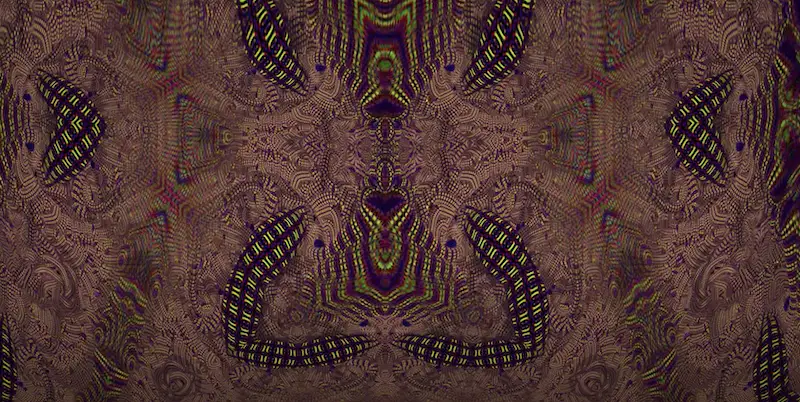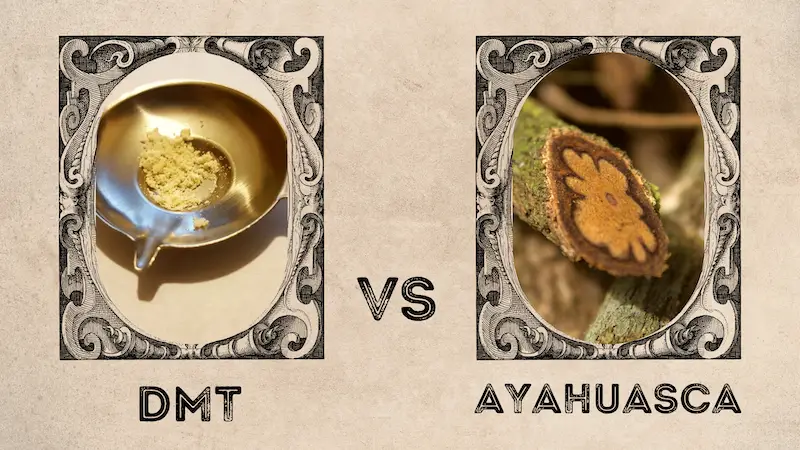A medicine man I used to drink ayahuasca with once told me, in response to my question about the differences between DMT and ayahuasca, “DMT is like a one-night-stand, like a lover and ayahuasca is the long-term relationship, it’s the building, growth and healing.”
Psychedelic substances are a group of powerful compounds that have been used for centuries to induce altered states of consciousness for spiritual, therapeutic, and recreational purposes. Many different plants and compounds exist within this category, with two of the most well-known and widely used being dimethyltryptamine (DMT) and ayahuasca.
Something important to point out is that the active ingredient in ayahuasca is DMT, though they are still considered different substances with differing effects.
This article will describe the differences between DMT and ayahuasca and explore the effects, uses, and historical significance of each substance.

Table of Contents
Overview of DMT
DMT is a naturally-occurring psychedelic compound found in many plants and animals throughout the world. It is derived from certain plants and is usually smoked as a powder. DMT produces profound alterations to the user’s perception of reality, typically characterized by vivid visual experiences, sensations of deep spiritual connection, and intense emotional and psychological insights. The effects of DMT usually last for about 30-60 minutes, depending on the dose and how it is taken.
Overview of Ayahuasca
Ayahuasca is an herbal brew containing a mix of the psychedelic substance dimethyltryptamine (DMT) and an MAO inhibitor. It is made from plants native to the Amazon region, such as psychotria viridis and banisteriopsis caapi. It is typically consumed in liquid form, and produces altered states of consciousness that may last several hours. The visual effects of ayahuasca can be more intense than those of DMT (always dependent on the dose and person), and it also produces significant changes in thought and emotion. Many people report experiences of clearing their minds, gaining insight into personal issues, and feeling a deep sense of connection with the universe.
Differences Between DMT and Ayahuasca
The main difference between the effects of DMT and those of ayahuasca is in the intensity and duration of their respective experiences. DMT produces a rapid, intense, and short-lived experience that generally lasts no more than an hour. On the other hand, ayahuasca is usually taken in larger doses, producing various effects that can last for several hours or longer, sometimes into the next two days! Additionally, because ayahuasca contains an MAO inhibitor, it can produce effects that are significantly more visual, intense, and long-lasting than those of DMT.
Another difference between DMT and ayahuasca is the way they are consumed. DMT is typically inhaled as a powder, while ayahuasca is usually consumed as a liquid, sometimes as a tea. The difference in delivery methods can drastically alter the experience of each substance, as each of them is metabolized differently. In addition, DMT can produce very intense effects after a single dose, whereas ayahuasca may require multiple doses or a longer period for the user to reach a peak level of intoxication.
Another important difference between DMT and ayahuasca is that ayahuasca often causes physical cleansing in the form of vomit or feces. You may experience discomfort in your bowels and stomach before, during and after consuming ayahuasca. It’s part of the internal work that needs to take place, but there are some brews of ayahuasca that are more forgiving in this aspect, including the one we prepare for our ayahuasca retreats.

Table: Differences between DMT and ayahuasca
| Aspect | DMT | Ayahuasca |
|---|---|---|
| Chemical makeup | DMT is a molecule | Ayahuasca is a brew made of DMT-containing plants and MAOI-containing plants |
| Duration of effects | Short, intense trip (15-30 min) | Longer-lasting experience (4-6 hours) due to MAOIs |
| Method of consumption | Smoked or vaporized | Consumed orally as a brew |
| Effects | Strong visual and auditory hallucinations | Altered consciousness, emotional breakthroughs, introspection |
| Medical use | None approved by FDA | Used in some forms of therapy for addiction and depression |
| Legal status | Controlled substance in many countries | Legal in some countries for religious or spiritual use |
Uses for DMT and Ayahuasca
DMT and ayahuasca have both been used for centuries for various purposes, including spiritual ceremonies and healing treatments. DMT is often associated with shamanic rituals and is used as an aid in meditation and spiritual exploration. Ayahuasca has been widely used in religious ceremonies throughout South America and is reported to have a more varied range of effects than DMT, ranging from intense visual hallucinations to profound psychological insights.
The therapeutic potential of both DMT and ayahuasca has been widely studied in recent years. Studies have found that both compounds can induce significant psychological and emotional healing when consumed in appropriate doses. For example, ayahuasca has been shown to be a powerful tool for treating addiction, depression, and anxiety, while DMT has been used to help patients cope with trauma and explore their spirituality.
Conclusion
DMT and ayahuasca are two powerful psychedelic compounds, each with their own unique effects and uses. DMT produces a rapid, intense, and short-lived intoxication, while ayahuasca tends to be more visual, intense, and long-lasting. Both substances have been used for centuries for their spiritual and healing properties, and their therapeutic potential has been the subject of much research. Ultimately, it is important to understand the differences between DMT and ayahuasca so that each can be safely and appropriately utilized for its intended purpose.



